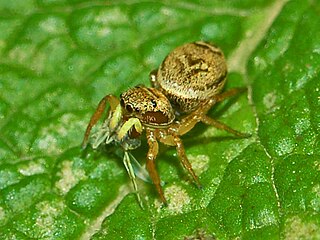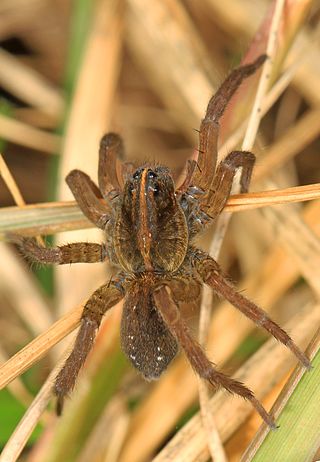
Wolf spiders are members of the family Lycosidae. They are robust and agile hunters with excellent eyesight. They live mostly in solitude, hunt alone, and usually do not spin webs. Some are opportunistic hunters, pouncing upon prey as they find it or chasing it over short distances; others wait for passing prey in or near the mouth of a burrow.

Brachypelma hamorii is a species of tarantula found in Mexico. It has been confused with B. smithi; both have been called Mexican redknee tarantulas. Many earlier sources referring to B. smithi either do not distinguish between the two species or relate to B. hamorii. B. hamorii is a terrestrial tarantula native to the western faces of the Sierra Madre Occidental and Sierra Madre del Sur mountain ranges in the Mexican states of Colima, Jalisco, and Michoacán. The species is a large spider, adult females having a total body length over 50 mm (2 in) and males having legs up to 75 mm (3 in) long. Mexican redknee tarantulas are a popular choice for enthusiasts. Like most tarantulas, it has a long lifespan.

Papilio (Chilasa) paradoxa, the great blue mime, is a swallowtail butterfly found in India and parts of South-East Asia. The butterfly belongs to the mime subgenus, Chilasa, of the genus Papilio. It is an excellent mimic of different species of Euploea.

Misumena vatia is a species of crab spider with a holarctic distribution. In North America, it is called the goldenrod crab spider or flower (crab) spider, as it is commonly found hunting in goldenrod sprays and milkweed plants. They are called crab spiders because of their unique ability to walk sideways as well as forwards and backwards. Both males and females of this species progress through several molts before reaching their adult sizes, though females must molt more to reach their larger size. Females can grow up to 10 mm (0.39 in) while males are quite small, reaching 5 mm (0.20 in) at most. Misumena vatia are usually yellow or white or a pattern of these two colors. They may also present with pale green or pink instead of yellow, again, in a pattern with white. They have the ability to change between these colors based on their surroundings through the molting process. They have a complex visual system, with eight eyes, that they rely on for prey capture and for their color-changing abilities. Sometimes, if Misumena vatia consumes colored prey, the spider itself will take on that color.

Peucetia viridans, the green lynx spider, is a bright-green lynx spider usually found on green plants. It is the largest North American species in the family Oxyopidae. This spider is common in the southern U.S., Mexico, Central America, and in many West Indies islands, especially Jamaica.

The Indian fritillary is a species of butterfly of the nymphalid or brush-footed family. It is usually found from south and southeast Asia to Australia.

Metepeira labyrinthea, the labyrinth orbweaver, is a spider, with thin legs and a round, bulbous abdomen It is a member of the genus Metepeira in the family Araneidae. The female’s length is 5.3 mm, its carapace 2.3 mm, abdomen 3.3 mm, and extended legs 18.4 mm. The carapace is brown or gray, and the abdomen is dark with a white pattern. The legs alternate pale brown and dark brown, and the sternum is dark brown with a longitudinal yellow mark. The male spider is three-quarters of the female’s length, or slightly larger, with a darker carapace and with greater contrast between dark and light areas of the legs. Metepeira are easily distinguished from other Araneidae by their light eye region, white median line on the sternum, relative length of the leg segments, small male palpus, weakly sclerotized epigyne and the special composite web.

Zygoballus sexpunctatus is a species of jumping spider which occurs in the southeastern United States where it can be found in a variety of grassy habitats. Adult spiders measure between 3 and 4.5 mm in length. The cephalothorax and abdomen are bronze to black in color, with reddish brown or yellowish legs. The male has distinctive enlarged chelicerae and front femora. Like many jumping spiders, Z. sexpunctatus males exhibit ritualized courtship and agonistic behavior.

Eastern forktail is a member of the damselfly family Coenagrionidae.

Rugathodes sexpunctatus is a minute species of spider in the family Theridiidae, the cobweb or tangle-web spiders. This family includes the medically important genus Latrodectus—the widow spiders. The species in the genus Rugathodes are too small to be dangerous to humans. Very little is known about most species in this genus.

Trichopoda pennipes is a species of feather-legged fly in the dipteran family Tachinidae.

Neoscona domiciliorum, commonly known as the spotted orbweaver or redfemured spotted orbweaver, is a spider in the family Araneidae. The specific epithet domiciliorum means "of dwellings" in Latin and refers to the fact that this species is often found living on buildings. Their bites are not known to cause serious harm in humans.

Heliophanus tribulosus is a species of 'jumping spiders' belonging to the family Salticidae.

Araneus mitificus, commonly known as the kidney garden spider or pale orb weaver is a species of orb-weaver spider found in South, East, and Southeast Asia.

Rabidosa rabida, also known as the rabid wolf spider, is a species of spiders from the family Lycosidae, native to North America. In the United States it is found from Maine to Florida and west to Texas.

Pardosa amentata, otherwise known as the wolf spider or spotted wolf spider is a species of spider in the genus Pardosa belonging to the family of wolf spiders, Lycosidae. The species has a widespread distribution in central Europe and northwestern Europe and are commonly found on the British Isles. The species hunts its prey on the ground rather than weaving a web.

Progradungula otwayensis, commonly known as the odd-clawed spider, is a species of cribellate spider endemic to the Great Otway National Park of Victoria, Australia. It is one of only two species in the gradungulid genus Progradungula.

Tigrosa helluo is a species of spider belonging to the family Lycosidae, also known as wolf spiders. T. helluo was formerly known as Hogna helluo before differences between dorsal color patterns, habitat preferences, body structures, etc. were discovered. The species is native to the United States, Canada, and Mexico. It can be found across the eastern half of the United States, primarily in the Northeast and New England, and as far west as Nebraska and Kansas. T. helluo can be found in diverse habitats including woods, marshes, fields, and riparian areas. Typically, members of this species prefer to live in wetter areas as opposed to dry environments. Males tend to live for around a year and females will live for close to two years.

Dicromantispa sayi is a species of mantidfly in the family Mantispidae. It is found in the Caribbean Sea, Central America, and North America.
Schizocosa stridulans is a sibling species of S. ocreata and S. rovneri and is part of the wolf spider family. The name of the genus comes from the epigynum structure being lycosid and having a split T excavation. This spider is well-known for its specific leg ornamentation and courtship rituals and that is how it has been differentiated from its related species. The S. stridulans take systematic steps during its courtship ritual, which involves two independent signals. More specifically, female spiders will leave silk and pheromones to communicate that they are ready to mate.




















